Gallery
- Forest with a view of a clearing
- In June
- Forest
- Summer Flowers
Therese Schachner | |
|---|---|
| Born | 29 May 1869 Vienna, Austria |
| Died | 5 May 1950 (aged 80) Vienna, Austria |
| Nationality | Austrian |
| Known for | Painting |
Therese Schachner (1869-1950) was an Austrian artist.
Schachner was born on 29 May 1869 in Vienna, [1] the daughter of architect Friedrich Schachner . [2] She was a student of the Austrian landscape painter Hugo Darnaut. She also studied with Albin Egger-Lienz. [3]
Schachner died on 5 May 1950 in Vienna. [1] Her work is in the collection of the Belvedere Gallery. [4]
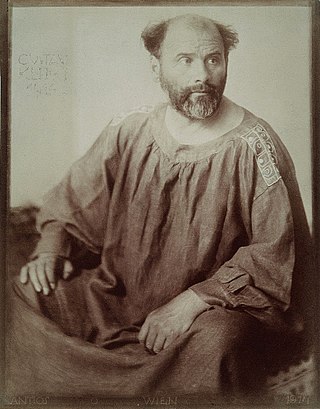
Gustav Klimt was an Austrian symbolist painter and one of the most prominent members of the Vienna Secession movement. Klimt is noted for his paintings, murals, sketches, and other objets d'art. Klimt's primary subject was the female body, and his works are marked by a frank eroticism. Amongst his figurative works, which include allegories and portraits, he painted landscapes. Among the artists of the Vienna Secession, Klimt was the most influenced by Japanese art and its methods.
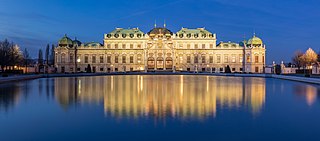
The Belvedere is a historic building complex in Vienna, Austria, consisting of two Baroque palaces, the Orangery, and the Palace Stables. The buildings are set in a Baroque park landscape in the third district of the city, on the south-eastern edge of its centre. It houses the Belvedere museum. The grounds are set on a gentle gradient and include decorative tiered fountains and cascades, Baroque sculptures, and majestic wrought iron gates. The Baroque palace complex was built as a summer residence for Prince Eugene of Savoy.

Ferdinand Georg Waldmüller was an Austrian painter and writer. Waldmüller was one of the most important Austrian painters of the Biedermeier period.

The Österreichische Galerie Belvedere is a museum housed in the Belvedere palace, in Vienna, Austria.

Carl Julius Rudolf Moll was an Austrian Art Nouveau painter active in Vienna at the start of the 20th century. He was one of the artists of the Vienna Secession who took inspiration from the pointillist techniques of French Impressionists. He was an early supporter of the Nazis and committed suicide as Soviet forces approached Vienna at the end of World War II.

Portrait of Adele Bloch-Bauer I is an oil painting on canvas, with gold leaf, by Gustav Klimt, completed between 1903 and 1907. The portrait was commissioned by the sitter's husband, Ferdinand Bloch-Bauer, a Viennese and Jewish banker and sugar producer. The painting was stolen by the Nazis in 1941 and displayed at the Österreichische Galerie Belvedere. The portrait is the final and most fully representative work of Klimt's golden phase. It was the first of two depictions of Adele by Klimt—the second was completed in 1912; these were two of several works by the artist that the family owned.
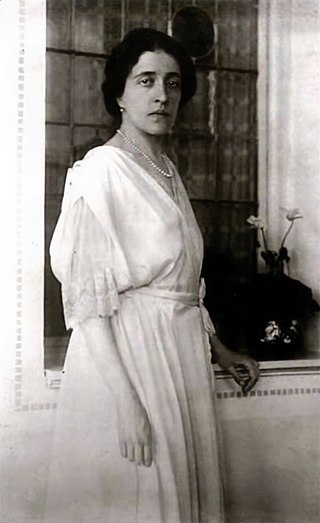
Adele Bloch-Bauer was a Viennese socialite, salon hostess, and patron of the arts from Austria-Hungary, married to sugar industrialist Ferdinand Bloch-Bauer. A Jewish woman, she is most well known for being the subject of two of artist Gustav Klimt's paintings: Portrait of Adele Bloch-Bauer I and Portrait of Adele Bloch-Bauer II, and the fate of the paintings during and after the Nazi Holocaust. She has been called "the Austrian Mona Lisa."
George Mayer-Marton was a Hungarian Jewish artist who was a significant figure in Viennese art between the First and Second World Wars, working in oil, watercolour and graphics. Following his forced emigration to England in 1938, he continued to paint in watercolour and oil. He pioneered the technique of Byzantine mosaic in the UK.

Robert Hammerstiel was an Austrian painter and engraver. His works are influenced by Serbian icon painting, wood-engraving and pop art. Hammerstiel was internationally recognized and received numerous awards. His home town installed a museum dedicated to his art.
Marina Faust is an Austrian artist.

Broncia Koller-Pinell was an Austrian Expressionist painter who specialized in portraits and still-lifes.
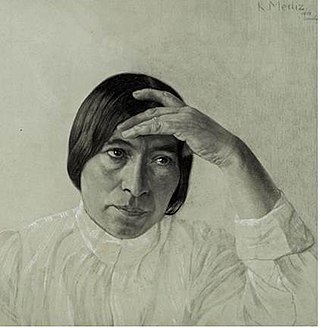
Emilie Mediz-Pelikan was an Austrian landscape painter. Many of her works show some Symbolist influence.

Albert Reuss was an Austrian-born British painter and sculptor. He was born in Vienna and fled to Britain in 1938 following the Anschluss, Adolf Hitler’s annexation of Austria to the German Reich. In the process, Reuss lost many members of his family, and the reputation he had built up as an artist in Vienna. He continued to work as an exiled artist, but his style changed dramatically, reflecting the trauma he had suffered. Many public collections in Britain hold his work, most notably Newlyn Art Gallery in Cornwall, the British Museum and the Victoria and Albert Museum in London, the Österreichische Galerie Belvedere and the Albertina both in Vienna, and the Tel Aviv Museum of Art in Israel.

Helene Funke was a German-Austrian painter and graphic designer of modern times.
Emma Schlangenhausen (1882-1947) was an Austrian painter and a graphic artist.
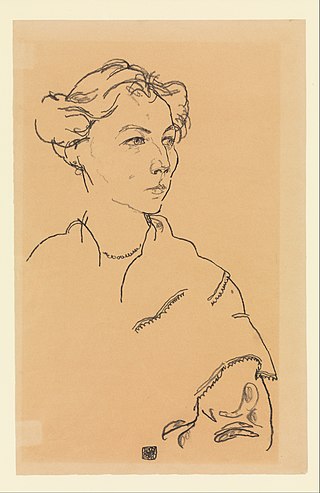
Lilly Steiner (1884–1961) was an Austrian painter and graphic artist.
Lea Bondi, later Lea Jaray or Lea Bondi-Jaray was an Austrian art dealer and art collector who was forced to emigrate to Great Britain due to Nazi persecution after the annexation of Austria to the Nazi German Reich. The Würthle Gallery, which she ran, was "Aryanized" by Nazis and her art collection, including the Portrait of Wally by Egon Schiele, extorted.

Josephine Therese (Pepi) Weixlgärtner-Neutra was an Austrian-Swedish artist, who concentrated on graphic design, painting, sculpture and enamelwork.

Agnes Husslein, also Agnes Husslein-Arco, is an Austrian art historian and art manager.
Margaretha Maria Josefa "Greta" Freist was an Austrian painter and graphic artist.